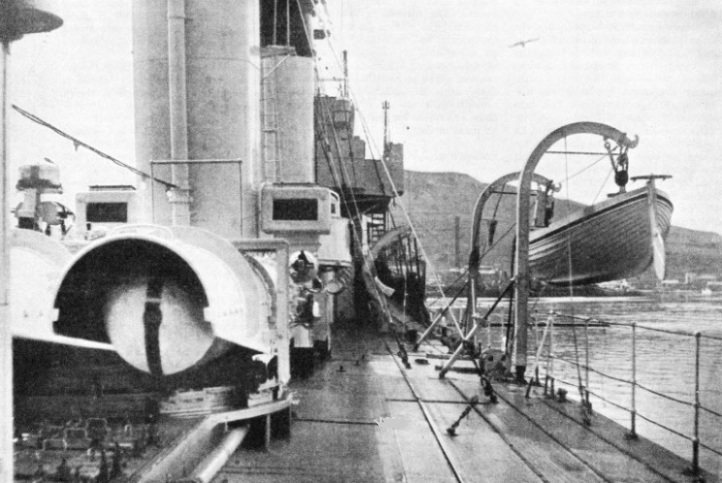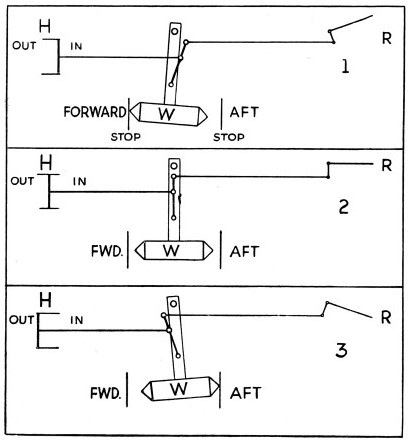

© Shipping Wonders of the World 2012-

Design of the Torpedo
A formidable weapon in time of war, the modern torpedo is also a complex piece of machinery. It embodies many ingenious devices for the purpose of keeping it trained on its target and at a uniform depth below the surface of the water

TORPEDO TUBES on the deck of H.M. flotilla leader Kempenfelt. This ship, built in 1932, has a displacement of 1,390 tons. Her geared turbines of 36,000 horse-
CREDIT for the torpedo as we know it to-
In 1866 Whitehead, assisted by his young son and one workman, built his first torpedo in conditions of strict secrecy. The torpedo was of steel, cigar-
During the next two years the vital problem of running below the surface at a uniform depth was worked out behind locked and guarded doors, and finally the famous “balance chamber” was designed.
By 1876 the Whitehead torpedo had attained a speed of 18 knots for a distance of 600 yards. It now carried a 26 lb. charge of guncotton, and was able to keep to a true path in the water. The weapon was re-
One of the most important improvements (apart from the balance chamber) introduced in the design of the torpedo was the gyroscope control gear invented by Ludwig Obry, of Trieste, who sold the idea to Robert Whitehead. The gyroscope controls the path of the torpedo and keeps it dead on the target in much the same way as the famous gyroscopic “metal mike” keeps a ship steered on her true course. The depth at which a torpedo runs is controlled by its horizontal rudders (worked from the balance chamber), and if it rolls these rudders may stand upright and so alter direction to port or starboard. The gyroscope gear, attached to vertical rudders, overcomes this difficulty and also corrects any deflection due to dents in the torpedo hull or other causes. So marked is this tendency of the gyroscope to continue to spin in one plane that a torpedo can be pre-
The first successful use of the Whitehead torpedo in wartime was on January 25, 1878, when the Russian warships Tchesme and Sinope each fired one Whitehead torpedo at a Turkish revenue cutter in the entrance to Batum harbour. Both torpedoes exploded and the Turkish vessel was immediately sunk. On April 23, 1891, during one of Chile’s earlier revolutions, the insurgent battleship Blanco Encalada was torpedoed in Caldera Bay by two government torpedo-
By 1907 the British Whitehead torpedo had grown to a diameter of 18 in. with a charge of 205 lb. of guncotton. It had a speed of 33 knots for 1,000 yards declining to 19 knots at its maximum range of 4,000 yards. The
French Navy had adopted an 18 in. torpedo carrying 198 lb. of explosive and having a maximum range of 3,000 yards. The German torpedo of this period had a speed of 30 knots, and a maximum range of 2,500 yards, and carried 246 lb. of explosive.
An interesting torpedo of the time was the Bliss-

THE LAY-
Another important torpedo was the Davis-
The Brennan torpedo, introduced by its inventor in 1877, was primarily intended for coast defence. Its driving mechanism comprised two drums on which were wound light steel cables. On shore was erected a 100-
In addition to the 18-
The body of a Whitehead torpedo resembles a steel cigar rounded at the fore end, and tapering off aft to the tail. The head is detachable and in peace time a special practice-
Pressure of 2,000 lb.
The war head, however, is by no means as harmless as its peace time counterpart. It is packed with guncotton — compressed cotton that has been soaked in nitro-
The most important safeguard is a miniature propeller screwed on the end of the firing plunger. This propeller or “fan” is further secured by a removable pin against inadvertent unscrewing. When the torpedo has travelled for about 50 yards through the water the safety propeller has screwed itself off the end of the plunger. The firing plunger is then free to be driven into the fulminate when the torpedo strikes an enemy’s hull. It is not free, however, to explode the charge on striking, say, a small piece of floating wreckage. The blow must be comparatively heavy, because the plunger is provided with a copper pin that must be sheared off before it can be struck home.
On striking the target the torpedo blows to pieces and leaves an enormous hole in the plating of the enemy ship, well below the water-
Behind the head, and occupying about half the volume of the whole torpedo, is the air chamber, in which is stored compressed air at a pressure of over 2,000 lb. per square inch.
The air chamber is made of the finest steel about ⅜-
The next compartment aft is the balance chamber, for long the hiding place of the Whitehead “secret” — the mechanism that enables the torpedo to run submerged on an even keel at any predetermined depth below the surface down to about 20 feet. In the balance chamber is a pendulum free to swing within limits in a fore and aft direction. Pivoted to the pendulum links is a
short lever, one end of which is connected, through a “servo-
A control gear is used in conjunction with the balance mechanism to keep the rudders fixed for a certain distance after firing. This overcomes the shock of discharge and of the initial dive.

AFTER ITS INITIAL DIVE, a torpedo is maintained on an even keel by the combined action of a valve (H) and a pendulum weight (W). The first diagram shows the position immediately after the dive. The weight swings forward and the pressure of water forces in the valve, these actions combining to elevate the horizontal rudder (R).
The second diagram shows the conditions in which the torpedo runs on an even keel.
The third diagram shows the means of counteracting a tendency to run upwards towards the surface, the valve and the weight combining to depress the rudder and to restore the correct balance.
The balance chamber contains also the stop-
Next is the engine compartment, containing a three-
In this compartment is the charging valve, through which compressed air is supplied to the air chamber. The charging valve also incorporates a starting valve, which releases air from the air chamber, through an automatic reducing valve that controls the pressure, to the engines.
The Buoyancy Chamber
The starting valve is operated by a cam turned by a projection in the torpedo tube immediately after firing. This starting valve is closed by a special counter-
The engine-
The next compartment aft is the buoyancy chamber containing the propeller shaft, diving rods, sinking valve, and the gyroscopic control. The gyroscope is a flywheel weighing nearly 2 lb. mounted in a frame in the lower part of the compartment. It is set spinning at over 2,000 revolutions a minute by gearing, similar to that on a bicycle bell, operated by a hand-
The gyroscope operates the vertical rudders through a system of levers and servo-
Finally, at the tail of the torpedo are the wheel gearing that makes the propellers revolve in opposite directions, the perpendicular fins, the horizontal and vertical rudders and the screw propellers.
The torpedo has revolutionized the conduct of war on the high seas; it has shaped the foreign policies of great nations and has worked its influence on the political histories of empires.
You can read more on “The Battle of Tsushima”, “Big Guns in Action” and “Undersea Weapons” on this website.